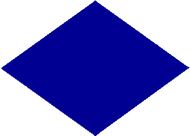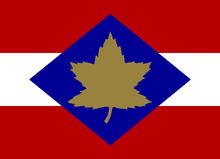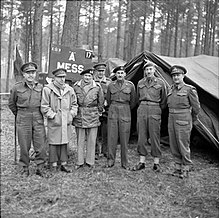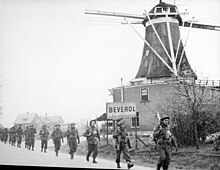
Operation Totalize was an offensive launched by Allied troops in the First Canadian Army during the later stages of Operation Overlord, from 8 to 9 August 1944. The intention was to break through the German defences south of Caen on the eastern flank of the Allied positions in Normandy and exploit success by driving south, to capture the high ground north of the city of Falaise. The goal was to collapse the German front and cut off the retreat of German forces fighting the Allied armies further west. The battle is considered the inaugural operation of the First Canadian Army, which had been activated on 23 July.

I Corps was an army corps in existence as an active formation in the British Army for most of the 80 years from its creation in the First World War until the end of the Cold War, longer than any other corps. It had a short-lived precursor during the Waterloo Campaign.

The 2nd Canadian Division, an infantry division of the Canadian Army, was mobilized for war service on 1 September 1939 at the outset of World War II. Adopting the designation of the 2nd Canadian Division, it was initially composed of volunteers within brigades established along regional lines, though a halt in recruitment in the early months of the war caused a delay in the formation of brigade and divisional headquarters. With questions concerning overseas deployment resolved, the division's respective commands were formed in May and June 1940, and at British Prime Minister Winston Churchill's request, the division was deployed to the United Kingdom between 1 August and 25 December 1940, forming part of the Canadian Corps.
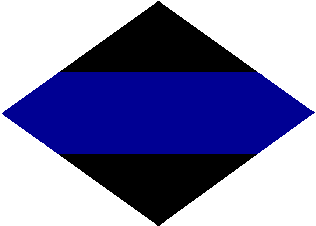
The 2nd Canadian Armoured Brigade was an armoured brigade of the Canadian Army that saw active service during World War II. The brigade was composed of the 6th, 10th and 27th Canadian Armoured regiments and saw service in northwest Europe, landing in Normandy on D-Day and remaining in combat up to Victory in Europe Day.

The 4th Canadian Armoured Brigade was an armoured brigade of the Canadian Army during World War II. It was part of the 4th Canadian (Armoured) Division.

The Guards Armoured Division was an armoured division of the British Army during the Second World War. The division was created in the United Kingdom on 17 June 1941 during the Second World War from elements of the Guards units, the Grenadier Guards, Coldstream Guards, Scots Guards, Irish Guards, Welsh Guards, and the Household Cavalry.

The 2nd Canadian Division is a formation of the Canadian Army in the province of Quebec, Canada. The present command was created 2013 when Land Force Quebec Area was re-designated. The main unit housed in this division is the Royal 22nd Regiment based at CFB Valcartier near Quebec City, which is the biggest regiment in the Canadian Army.

The 3rd Canadian Division is a formation of the Canadian Army responsible for the command and mobilization of all army units in the provinces of Manitoba, Saskatchewan, Alberta and British Columbia, as well as all units extending westwards from the city of Thunder Bay.

The 4th Canadian Division is a formation of the Canadian Army. The division was first created as a formation of the Canadian Corps during the First World War. During the Second World War the division was reactivated as the 4th Canadian Infantry Division in 1941 and then converted to armour and redesignated as the 4th Canadian (Armoured) Division. Beginning in 1916 the division adopted a distinctive green-coloured formation patch as its insignia. In 2013 it was announced that Land Force Central Area would be redesignated 4th Canadian Division. It is currently responsible for Canadian Army operations in the Canadian province of Ontario and is headquartered at Denison Armoury in Toronto.

The 11th Armoured Division was an armoured division of the British Army which was created in March 1941 during the Second World War. The division was formed in response to the unanticipated success of the German panzer divisions. The 11th Armoured was responsible for several major victories in the Battle of Normandy from in the summer of 1944, shortly after the Normandy landings, and it participated in the Allied advance from Paris to the Rhine, the Rhine crossing in March 1945. It was disbanded in January 1946 and reformed towards the end of 1950. In 1956, it was converted into the 4th Infantry Division.

Operation Tractable was the final attack conducted by Canadian and Polish troops, supported by a British tank brigade, during the Battle of Normandy during World War II. The operation was to capture the tactically important French town of Falaise and then the smaller towns of Trun and Chambois. This operation was undertaken by the First Canadian Army with the 1st Polish Armoured Division and a British armoured brigade against Army Group B of the Westheer in what became the largest encirclement on the Western Front during the Second World War. Despite a slow start and limited gains north of Falaise, novel tactics by the 1st Polish Armoured Division during the drive for Chambois enabled the Falaise Gap to be partially closed by 19 August 1944, trapping about 150,000 German soldiers in the Falaise Pocket.

Operation Anger was a military operation to seize the city of Arnhem in April 1945, during the closing stages of the Second World War. It is also known as the Second Battle of Arnhem or the Liberation of Arnhem. The operation was part of the Canadian First Army's liberation of the Netherlands and was led by the 49th British Infantry Division, supported by armour of the 5th Canadian Armoured Division, Royal Air Force air strikes and boats of the Royal Navy.

Operation Spring was an offensive operation of the Second World War conducted by II Canadian Corps during the Normandy campaign in 1944. The plan was intended to create pressure on the German forces operating on the British and Canadian front simultaneous with Operation Cobra, an American offensive. Operation Spring was intended to capture Verrières Ridge and the villages on the south slope of the ridge. The German defence of the ridge contained the offensive on the first day and inflicted many casualties on the Canadians.

Operation Atlantic was a Canadian offensive during the Battle of Normandy in the Second World War. The offensive, launched in conjunction with Operation Goodwood by the Second Army, was part of operations to seize the French city of Caen and vicinity from German forces. It was initially successful, with gains made on the flanks of the Orne River near Saint-André-sur-Orne but an attack by the 4th and 6th Canadian Infantry Brigades of the 2nd Canadian Infantry Division, against strongly defended German positions on Verrières Ridge to the south was a costly failure.

The Battle of Verrières Ridge was a series of engagements fought as part of the Battle of Normandy, in Calvados, during the Second World War. The main combatants were two Canadian infantry divisions—with additional support from the Canadian 2nd Armoured Brigade—against elements of three German SS Panzer divisions. The battle was part of the British and Canadian tacks south of Caen, and took place from 19 to 25 July 1944, being part of Operation Atlantic and Operation Spring.
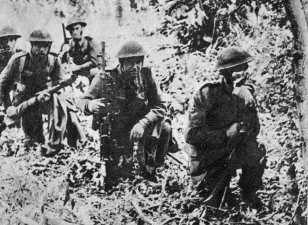
Battle of Hill 262, or the Mont Ormel ridge, is an area of high ground above the village of Coudehard in Normandy that was the location of a bloody engagement in the final stages of the Battle of Falaise in the Normandy Campaign during the Second World War. By late summer 1944, the bulk of two German armies had become surrounded by the Allies near the town of Falaise. The Mont Ormel ridge, with its commanding view of the area, sat astride the only escape route still open to the Germans. Polish forces seized the northern height of the ridge on 19 August and held it until noon on 21 August, despite determined attempts by German units to overrun the position, contributing greatly to the Allied victory.
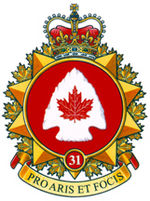
31 Canadian Brigade Group is part of the 4th Canadian Division, under the Canadian Army. It encompasses the southwestern portion of Ontario, and is headquartered in London, Ontario. The 31 CBG area of responsibility stretches from Hamilton to Windsor. The brigade has approximately 2,400 soldiers. Colonel Chris Brown, CD is Commander of 31 Canadian Brigade Group. The brigade sergeant-major is Chief Warrant Officer Mike Coit, CD.
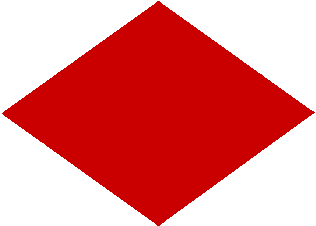
I Canadian Corps was one of the two corps fielded by the Canadian Army during the Second World War.

The First Canadian Army was a field army and a formation of the Canadian Army in World War II in which most Canadian elements serving in North-West Europe were assigned. It served on the Western Front from July 1944 until May 1945.

This is the Juno Beach order of battle on D-Day.
